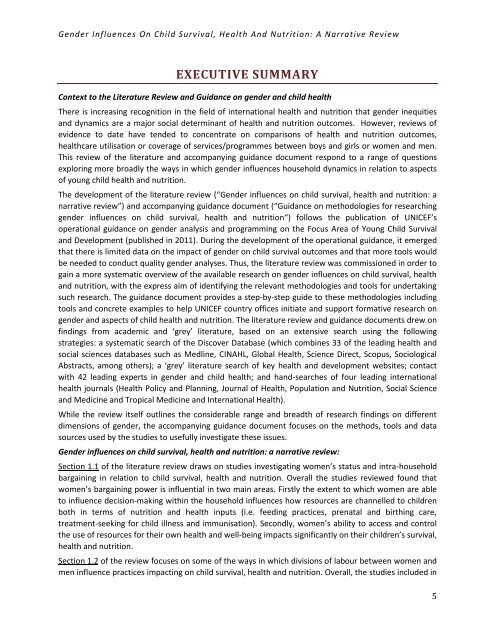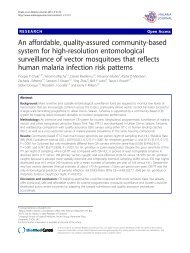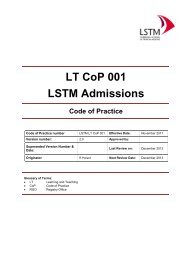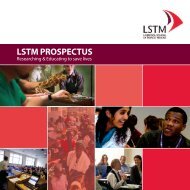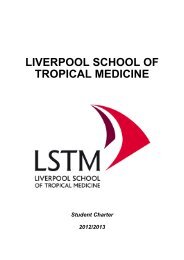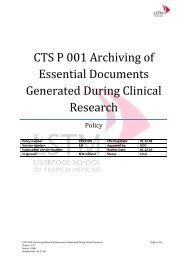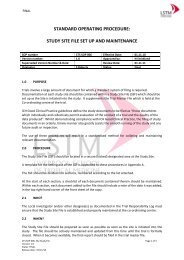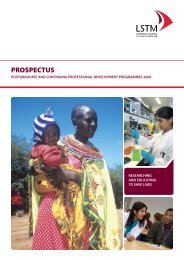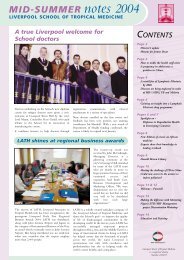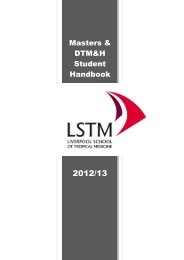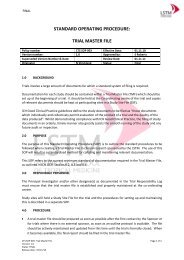Gender influences on child survival, health and nutrition: a ... - Unicef
Gender influences on child survival, health and nutrition: a ... - Unicef
Gender influences on child survival, health and nutrition: a ... - Unicef
You also want an ePaper? Increase the reach of your titles
YUMPU automatically turns print PDFs into web optimized ePapers that Google loves.
<str<strong>on</strong>g>Gender</str<strong>on</strong>g> Influences On Child Survival, Health And Nutriti<strong>on</strong>: A Narrative Review<br />
EXECUTIVE SUMMARY<br />
C<strong>on</strong>text to the Literature Review <strong>and</strong> Guidance <strong>on</strong> gender <strong>and</strong> <strong>child</strong> <strong>health</strong><br />
There is increasing recogniti<strong>on</strong> in the field of internati<strong>on</strong>al <strong>health</strong> <strong>and</strong> nutriti<strong>on</strong> that gender inequities<br />
<strong>and</strong> dynamics are a major social determinant of <strong>health</strong> <strong>and</strong> nutriti<strong>on</strong> outcomes. However, reviews of<br />
evidence to date have tended to c<strong>on</strong>centrate <strong>on</strong> comparis<strong>on</strong>s of <strong>health</strong> <strong>and</strong> nutriti<strong>on</strong> outcomes,<br />
<strong>health</strong>care utilisati<strong>on</strong> or coverage of services/programmes between boys <strong>and</strong> girls or women <strong>and</strong> men.<br />
This review of the literature <strong>and</strong> accompanying guidance document resp<strong>on</strong>d to a range of questi<strong>on</strong>s<br />
exploring more broadly the ways in which gender <str<strong>on</strong>g>influences</str<strong>on</strong>g> household dynamics in relati<strong>on</strong> to aspects<br />
of young <strong>child</strong> <strong>health</strong> <strong>and</strong> nutriti<strong>on</strong>.<br />
The development of the literature review (“<str<strong>on</strong>g>Gender</str<strong>on</strong>g> <str<strong>on</strong>g>influences</str<strong>on</strong>g> <strong>on</strong> <strong>child</strong> <strong>survival</strong>, <strong>health</strong> <strong>and</strong> nutriti<strong>on</strong>: a<br />
narrative review”) <strong>and</strong> accompanying guidance document (“Guidance <strong>on</strong> methodologies for researching<br />
gender <str<strong>on</strong>g>influences</str<strong>on</strong>g> <strong>on</strong> <strong>child</strong> <strong>survival</strong>, <strong>health</strong> <strong>and</strong> nutriti<strong>on</strong>“) follows the publicati<strong>on</strong> of UNICEF’s<br />
operati<strong>on</strong>al guidance <strong>on</strong> gender analysis <strong>and</strong> programming <strong>on</strong> the Focus Area of Young Child Survival<br />
<strong>and</strong> Development (published in 2011). During the development of the operati<strong>on</strong>al guidance, it emerged<br />
that there is limited data <strong>on</strong> the impact of gender <strong>on</strong> <strong>child</strong> <strong>survival</strong> outcomes <strong>and</strong> that more tools would<br />
be needed to c<strong>on</strong>duct quality gender analyses. Thus, the literature review was commissi<strong>on</strong>ed in order to<br />
gain a more systematic overview of the available research <strong>on</strong> gender <str<strong>on</strong>g>influences</str<strong>on</strong>g> <strong>on</strong> <strong>child</strong> <strong>survival</strong>, <strong>health</strong><br />
<strong>and</strong> nutriti<strong>on</strong>, with the express aim of identifying the relevant methodologies <strong>and</strong> tools for undertaking<br />
such research. The guidance document provides a step-by-step guide to these methodologies including<br />
tools <strong>and</strong> c<strong>on</strong>crete examples to help UNICEF country offices initiate <strong>and</strong> support formative research <strong>on</strong><br />
gender <strong>and</strong> aspects of <strong>child</strong> <strong>health</strong> <strong>and</strong> nutriti<strong>on</strong>. The literature review <strong>and</strong> guidance documents drew <strong>on</strong><br />
findings from academic <strong>and</strong> ‘grey’ literature, based <strong>on</strong> an extensive search using the following<br />
strategies: a systematic search of the Discover Database (which combines 33 of the leading <strong>health</strong> <strong>and</strong><br />
social sciences databases such as Medline, CINAHL, Global Health, Science Direct, Scopus, Sociological<br />
Abstracts, am<strong>on</strong>g others); a ‘grey’ literature search of key <strong>health</strong> <strong>and</strong> development websites; c<strong>on</strong>tact<br />
with 42 leading experts in gender <strong>and</strong> <strong>child</strong> <strong>health</strong>; <strong>and</strong> h<strong>and</strong>-searches of four leading internati<strong>on</strong>al<br />
<strong>health</strong> journals (Health Policy <strong>and</strong> Planning, Journal of Health, Populati<strong>on</strong> <strong>and</strong> Nutriti<strong>on</strong>, Social Science<br />
<strong>and</strong> Medicine <strong>and</strong> Tropical Medicine <strong>and</strong> Internati<strong>on</strong>al Health).<br />
While the review itself outlines the c<strong>on</strong>siderable range <strong>and</strong> breadth of research findings <strong>on</strong> different<br />
dimensi<strong>on</strong>s of gender, the accompanying guidance document focuses <strong>on</strong> the methods, tools <strong>and</strong> data<br />
sources used by the studies to usefully investigate these issues.<br />
<str<strong>on</strong>g>Gender</str<strong>on</strong>g> <str<strong>on</strong>g>influences</str<strong>on</strong>g> <strong>on</strong> <strong>child</strong> <strong>survival</strong>, <strong>health</strong> <strong>and</strong> nutriti<strong>on</strong>: a narrative review:<br />
Secti<strong>on</strong> 1.1 of the literature review draws <strong>on</strong> studies investigating women’s status <strong>and</strong> intra-household<br />
bargaining in relati<strong>on</strong> to <strong>child</strong> <strong>survival</strong>, <strong>health</strong> <strong>and</strong> nutriti<strong>on</strong>. Overall the studies reviewed found that<br />
women’s bargaining power is influential in two main areas. Firstly the extent to which women are able<br />
to influence decisi<strong>on</strong>-making within the household <str<strong>on</strong>g>influences</str<strong>on</strong>g> how resources are channelled to <strong>child</strong>ren<br />
both in terms of nutriti<strong>on</strong> <strong>and</strong> <strong>health</strong> inputs (i.e. feeding practices, prenatal <strong>and</strong> birthing care,<br />
treatment-seeking for <strong>child</strong> illness <strong>and</strong> immunisati<strong>on</strong>). Sec<strong>on</strong>dly, women’s ability to access <strong>and</strong> c<strong>on</strong>trol<br />
the use of resources for their own <strong>health</strong> <strong>and</strong> well-being impacts significantly <strong>on</strong> their <strong>child</strong>ren’s <strong>survival</strong>,<br />
<strong>health</strong> <strong>and</strong> nutriti<strong>on</strong>.<br />
Secti<strong>on</strong> 1.2 of the review focuses <strong>on</strong> some of the ways in which divisi<strong>on</strong>s of labour between women <strong>and</strong><br />
men influence practices impacting <strong>on</strong> <strong>child</strong> <strong>survival</strong>, <strong>health</strong> <strong>and</strong> nutriti<strong>on</strong>. Overall, the studies included in<br />
5


